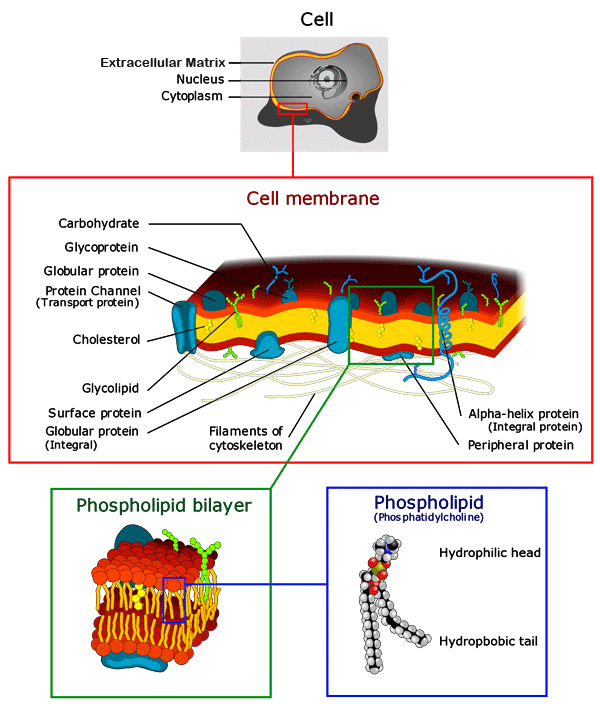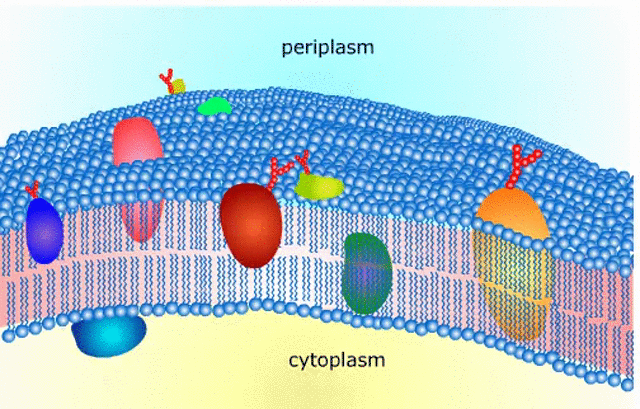13 Membranes
Membrane Lipids
The cell membrane is a dynamic structure composed of lipids, proteins, and carbohydrates. It protects the cell by preventing materials from leaking out, controls what can enter or leave through the membrane, provides a binding site for hormones and other chemicals, and serves as an identification card for the immune system to distinguish between “self” and “non-self” cells. We will first investigate the anatomy of the cell membrane and then continue on to study the physiology of membrane transport.
The phospholipid bilayer is the main fabric of the membrane. The bilayer’s structure causes the membrane to be semi-permeable. Remember that phospholipid molecules are amphiphilic (amphipathic), which means that they contain both a nonpolar and polar region. Phospholipids have a polar head (it contains a charged phosphate group) with two nonpolar hydrophobic fatty acid tails. The tails of different phospholipids face each other in the core of the membrane while the polar heads face either the exterior of interior of the cell. Having the polar heads oriented toward the external and internal sides of the membrane allows them to interact with the polar water molecules found on each side of the membrane. The hydrophobic core blocks the diffusion of hydrophilic ions and polar molecules. Small hydrophobic molecules and gases, which can dissolve in the membrane’s core, cross it with ease.
Other molecules require proteins to transport them across the membrane. Proteins determine most of the membrane’s specific functions. The plasma membrane and the membranes of the various organelles each have unique collections of proteins. For example, to date more than 50 kinds of proteins have been found in the plasma membrane of red blood cells [1].

Importance of Phospholipid Membrane Structure
What is important about the structure of a phospholipid membrane? First, it is fluid. This allows cells to change shape, permitting growth and movement. The fluidity of the membrane is regulated by the types of phospholipids and the presence of cholesterol. Second, the phospholipid membrane is selectively permeable.
The ability of a molecule to pass through the membrane depends on its polarity and to some extent its size. Many non-polar molecules such as oxygen, carbon dioxide, and small hydrocarbons can flow easily through cell membranes. This feature of membranes is very important because hemoglobin, the protein that carries oxygen in our blood, is contained within red blood cells. Oxygen must be able to freely cross the membrane so that hemoglobin can get fully loaded with oxygen in our lungs, and deliver it effectively to our tissues.
Most polar substances are stopped by a cell membrane, except perhaps for small polar compounds like the one carbon alcohol, methanol. Glucose is too large to pass through the membrane unassisted and a special transporter protein ferries it across. One type of diabetes is caused by misregulation of the glucose transporter. This decreases the ability of glucose to enter the cell and results in high blood glucose levels.
Charged ions, such as sodium (Na+) or potassium (K+) ions seldom go through a membrane, consequently they also need special transporter molecules to pass through the membrane. The inability of Na+ and K+ to pass through the membrane allows the cell to regulate the concentrations of these ions on the inside or outside of the cell. The conduction of electrical signals in your neurons is based on the ability of cells to control Na+ and K+ levels.
Selectively permeable membranes allow cells to keep the chemistry of the cytoplasm different from that of the external environment. It also allows them to maintain chemically unique conditions inside their organelles.
Fluidity of Cell Membranes
The cell membrane is not a static structure. It is a dynamic structure that allows for the lateral movement of phospholipids and proteins. Fluidity is a term used to describe the ease of movement of molecules in the membrane and is an important characteristic for cell function. Fluidity is dependent on the temperature (increased temperatures increase fluidity and decreased temperatures decrease fluidity), and the concentrations of saturated fatty acids and unsaturated fatty acids. Saturated fatty acids make the membrane less fluid while unsaturated fatty acids make it more fluid. The correct ratio of saturated to unsaturated fatty acids keeps the membrane fluid at any temperature conducive to life. In animal cells, cholesterol helps to prevent the packing of fatty acid tails and thus lowers the requirement of unsaturated fatty acids. This helps maintain the fluid nature of the cell membrane without it becoming too liquid at body temperature.
The lipid bilayer is the main fabric of the membrane, and its structure creates a semipermeable membrane. The hydrophobic core impedes the diffusion of hydrophilic structures such as ions and polar molecules, but allows hydrophobic molecules, which can dissolve in the membrane, to cross it with ease. The lipids in the membrane are in random bulk flow moving about 22 µm (micrometers) per second. Phospholipids freely move in the same layer of the membrane and rarely flip to the other layer. Flipping of phospholipids from one layer to the other rarely occurs because flipping requires the hydrophilic head to pass through the hydrophobic region of the bilayer.
Membrane Proteins
Membranes also contain proteins, which carry out many of the functions of the membrane. Some functions of membrane proteins are:
- Transport. Because the plasma membrane provide a barrier to the movement of many molecules, the cell needs a way to transport larger materials and hydrophilic molecules into and out of the cell.
- Communication. Because the plasma membrane is the border of the cell, this is where the cell communicates with its environment. Membrane proteins are able to receive signals from outside the cell and begin a chain of events that cause the cell to respond to these signals.
- Metabolism. Membrane proteins can be enzymes that are involved in the chemical reactions of metabolism. These are the processes that allow the cell to grow, obtain energy, and eliminate wastes.
- Adhesion. Membrane proteins help cells bind to each other so that they can form tissues. One example of this is skin cells, which must form a tight, waterproof connection between the cells in order to maintain proper integrity of the skin as an organ. Membrane proteins also bind to structural molecules inside and outside the cell so that cellular structure can be maintained.
Membrane proteins are classified into two major categories: integral proteins and peripheral proteins. Integral membrane proteins are those proteins that are embedded in the lipid bilayer and are generally characterized by their solubility in nonpolar, hydrophobic solvents. Transmembrane proteins are examples of integral proteins with hydrophobic regions that completely span the hydrophobic interior of the membrane. The parts of the protein exposed to the interior and exterior of the cell are hydrophilic. Integral proteins can serve as pores that selectively allow ions, nutrients, and wastes into or out of the cell. They can also transmit signals across the membrane.
Unlike integral proteins that span the membrane, peripheral proteins reside on only one side of the membrane and are often attached to integral proteins. Some peripheral proteins serve as anchor points for the cytoskeleton or extracellular fibers. Proteins are much larger than lipids and move more slowly than phospholipids in the membrane. Some move in a seemingly directed manner, while others drift. Some are glycoproteins which have a carbohydrate group attached to the protein. These are on the outside of the membrane and important for cell recognition, they work like a cellular identification card.

- Image: The Composition of a Cell Membrane, Image description: The cell membrane separates the interior of a cell from the outer environment. Cell membranes also regulate which materials can pass through in either direction. The cell membrane is composed of a phospholipid bilayer with many different molecular components attached, including proteins, cholesterol, and carbohydrate groups. The phospholipid bilayer consists of two layers of phospholipids (phosphatidylcholines). Each one of these lipids has a phosphate group hydrophilic “head” and a hydrophobic “tail” made up of fatty acid chains. The phospholipids are arranged in parallel layers, forming a flat sheet, with the tails associating in the interior of the membrane, and the heads oriented outwards, in contact with the environment inside and outside of the cell. ↵

